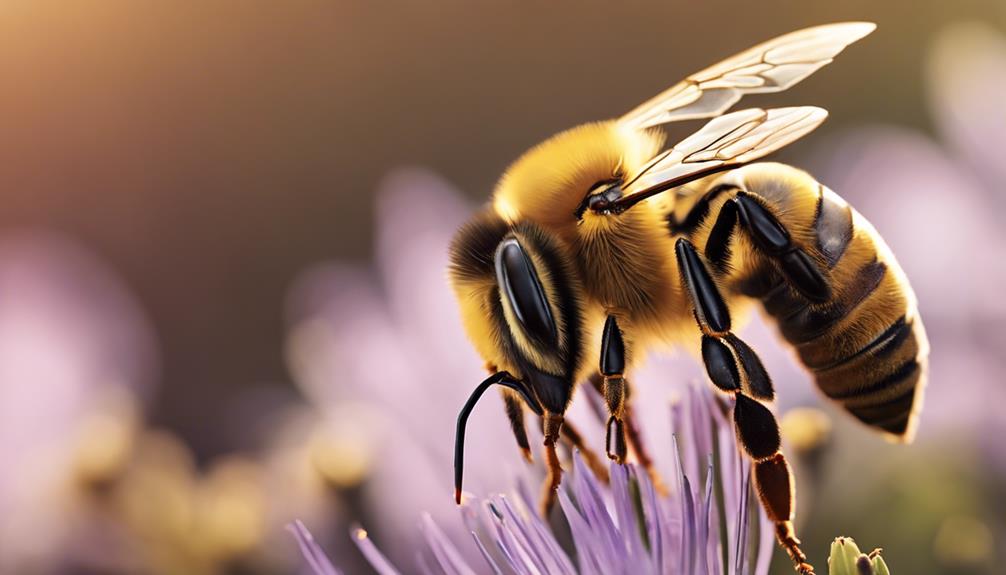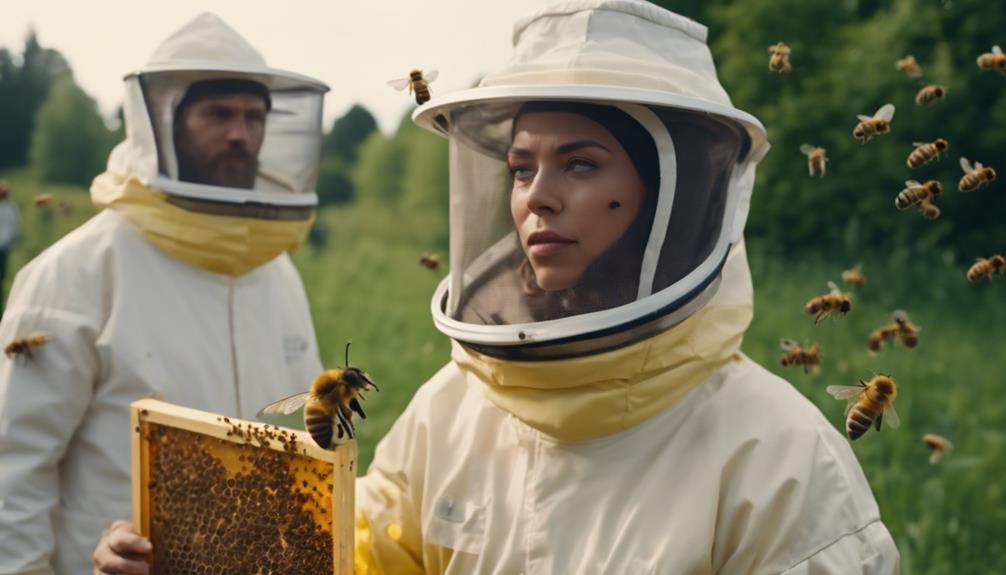Worker bees are undeniably female because of their genetic makeup, sporting a double set of chromosomes that distinctly mark their gender. This genetic blueprint decrees that worker bees develop from fertilized eggs, while their male counterparts (drones) arise from unfertilized eggs with only one set of chromosomes. The intriguing interplay of genetics determines not only their physical characteristics but also their roles within the hive. Stay tuned to uncover more fascinating facts about the world of worker bees and the intricate dynamics at play within their colonies.
Main Points
- Worker bees are genetic females with two sets of chromosomes.
- Female worker bees develop from fertilized eggs.
- Presence of ovaries confirms worker bees’ female gender.
- They lack mating ability and egg-laying capacity.
- Genetic determinants from the queen bee shape worker bee identity.
Genetic Determination of Worker Bee Gender
Understanding the genetic basis of worker bee gender is fundamental to comprehending their role within the hive. Worker bees are genetic females, possessing a double set of chromosomes, known as diploid. This genetic composition is what leads to the development of female worker bees.
On the other hand, male bees (drones) arise from unfertilized eggs containing a haploid set of chromosomes. The intricate process of genetic determination not only shapes the physical characteristics of worker bees but also plays an essential role in the division of labor within the colony.
Fertilization Process in Worker Bee Development
In worker bee development, the fertilization process plays a pivotal role in determining their female characteristics.
Sperm from mating interacts with the eggs laid by the queen bee, influencing the genetic makeup of the future worker bees.
This intricate process showcases how the queen bee’s choice of fertilizing eggs shapes the composition of the colony’s workforce.
Sperm and Egg
Worker bee females emerge from fertilized eggs containing both sperm from a drone and an egg from the queen, solidifying their female identity within the colony. Understanding the intricate dance between sperm and egg in worker bee development sheds light on their genetic makeup and eventual roles in the hive.
Here are some key points to ponder:
- Worker bees are female due to developing from fertilized eggs.
- The fusion of drone sperm and queen egg determines worker bee gender.
- Unfertilized eggs give rise to male drones, highlighting the importance of fertilization.
- Fertilization plays a critical role in shaping the genetic characteristics of worker bees.
- The process of sperm and egg interaction is fundamental in defining the female identity and reproductive functions of worker bees in the colony.
Genetic Determination
In the intricate dance of fertilization within worker bee development, the fusion of drone sperm and queen egg determines the genetic makeup and gender of the resulting female worker bees. This genetic process is essential as the fertilized eggs contain two sets of chromosomes, leading to the development of female worker bees.
It’s fascinating how this simple act of fertilization by the queen with stored sperm can influence the entire colony’s composition. The queen’s role in this process is pivotal, as she holds the key to the creation of future female workers.
Understanding the genetic determination of female worker bees sheds light on the unique and complex development that shapes the honeybee colony.
Role of Queen Bee in Worker Bee Gender
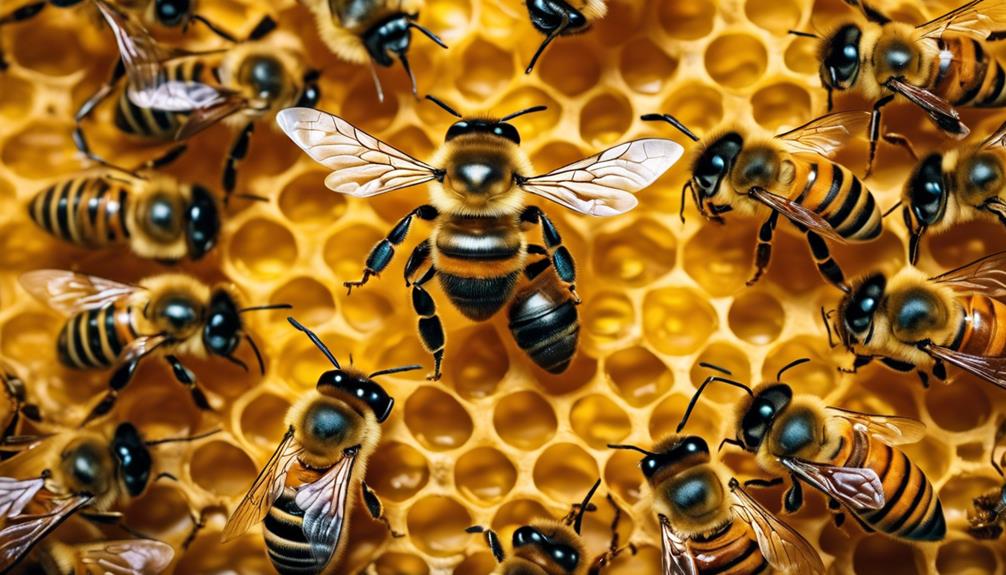
Queen bees play an essential role in determining the gender of worker bees within the colony.
By laying fertilized eggs that develop into female workers, queen bees wield significant influence over the population dynamics.
This genetic determination guarantees that worker bees remain exclusively female, contributing to the colony’s overall productivity and organization.
Queen Bee Influence
Fertilized eggs laid by the queen bee play an important role in determining the gender of worker bees within a hive. Here’s how the queen bee influences the gender of worker bees:
- The queen bee’s fertilization with stored sperm in her spermatheca decides the gender of worker bees.
- Female worker bees and future queens develop from these fertilized eggs, showcasing the queen bee’s genetic contribution.
- Drones, or male bees, arise from unfertilized eggs, a stark contrast to the female worker bees.
- The queen bee’s presence guarantees the continuous production of female worker bees, crucial for maintaining hive functions.
- Through her actions and fertilization processes, the queen bee exerts significant influence over the gender development of the worker bees in the colony.
Genetic Determination
Using genetic determinants inherited from the queen bee during egg fertilization, worker bees are female members of the hive. When the queen bee fertilizes an egg, she carefully chooses which sperms to use, ultimately determining the sex of the offspring.
Through this process, female worker bees inherit a pair of chromosomes that carry the genetic instructions for developing into females and exhibiting worker bee traits. These chromosomes contain important sex-determining alleles passed down from the queen bee.
As a result, worker bees play essential roles within the colony but are unable to lay fertile eggs themselves. This showcases their unique position as infertile females dedicated to the collective well-being of the hive.
The queen bee’s genetic influence is fundamental in shaping the identity and function of worker bees.
Distinction Between Male and Female Bees
Female worker bees can be distinguished from male bees through various genetic, anatomical, and behavioral characteristics. Here’s how you can tell them apart:
- Genetic Makeup: Worker bees have two sets of chromosomes, making them female.
- Ovaries: Even though undeveloped, the presence of ovaries in worker bees confirms their female gender.
- Mating Behavior: Worker bees lack the ability to mate or lay fertilized eggs, a trait specific to female bees.
- Anatomical Features: Female worker bees possess typical female honey bee features like stingers and pollen baskets.
- Reproductive Organs: The reproductive organs and behaviors of worker bees align with those of female bees, emphasizing their female identity.
These characteristics collectively define the distinction between male and female bees.
Impact of Genetic Makeup on Worker Bees
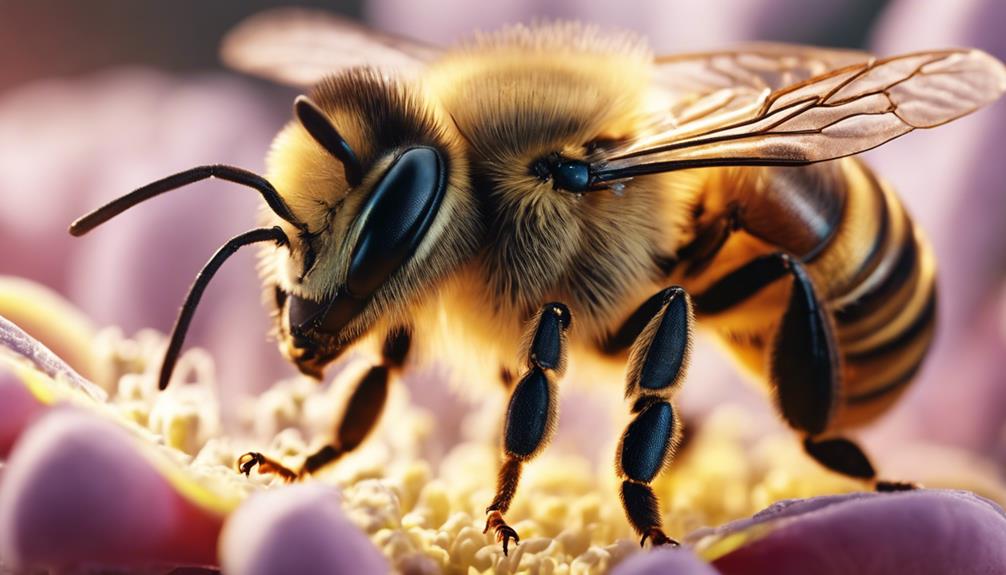
The genetic makeup of worker bees significantly influences their roles and behaviors within the hive, shaping their contributions to the colony’s functioning and survival. As females, worker bees inherit two sets of chromosomes, which define their characteristics and roles in the colony. This genetic predisposition also makes them infertile, focusing their energy on tasks that benefit the hive rather than individual reproduction.
These inherited traits enable worker bees to engage in altruistic behaviors, prioritizing the well-being of the colony. Nature has designed female worker bees with a selfless drive, ensuring the colony’s prosperity through their dedicated efforts. Understanding the impact of genetic makeup on worker bees sheds light on the intricate mechanisms that drive the harmonious functioning of a bee colony.
Division of Labor Among Female Bees
In the intricate ecosystem of a bee colony, female bees play essential roles through a vital division of labor. Here are some key aspects of the division of labor among female worker bees:
- Female worker bees focus on hive maintenance, ensuring the hive is a safe and clean environment for the entire colony.
- They dedicate themselves to caring for the queen bee, attending to her needs and ensuring her well-being.
- Altruistic behavior is prominent among female worker bees, as they prioritize the collective needs of the colony over their individual reproductive capabilities.
- The division of labor is vital for the overall efficiency and success of the hive, allowing each bee to contribute specialized skills.
- Through kin selection, the genetic predisposition of worker bees as females optimizes the colony’s functionality and survival.
Importance of Female Worker Bees
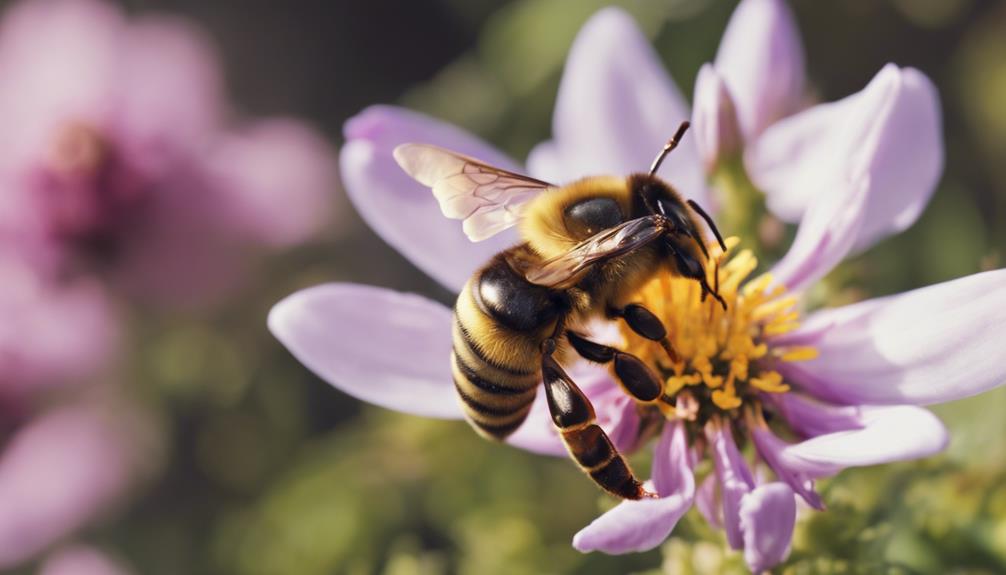
Shifting from investigating the division of labor among worker bees, we now recognize the vital role played by these hardworking females in the colony’s functioning. Female worker bees are the backbone of the hive, tirelessly tending to tasks like collecting nectar and pollen, caring for the queen, and maintaining the hive’s cleanliness. Without these dedicated workers, the hive would struggle to thrive and survive.
These bees exemplify selflessness, as they can’t reproduce but dedicate their lives to the well-being of the colony. Their genetic makeup predisposes them to exhibit behaviors essential for the hive’s success. From foraging to nursing the young, female worker bees are the unsung heroes that keep the hive buzzing with life and productivity.
Biological Factors Influencing Bee Gender
Exploring the biological factors influencing bee gender reveals intricate mechanisms shaping the division of labor within a hive. Here are some key points to ponder:
- Worker bees are female due to their genetic makeup, with two sets of chromosomes determining their gender.
- The presence of a reproductive system and ovaries in worker bees is an important biological factor indicating their female gender.
- Worker bees lack the ability to mate and lay fertilized eggs, reinforcing their role as non-reproductive females in the colony.
Female worker bees develop specialized glands for tasks like producing royal jelly, feeding larvae, and secreting beeswax.
- The absence of male reproductive organs like testes and the inability to produce sperm further solidifies worker bees’ female identity within the hive.
Genetic Characteristics of Worker Bees
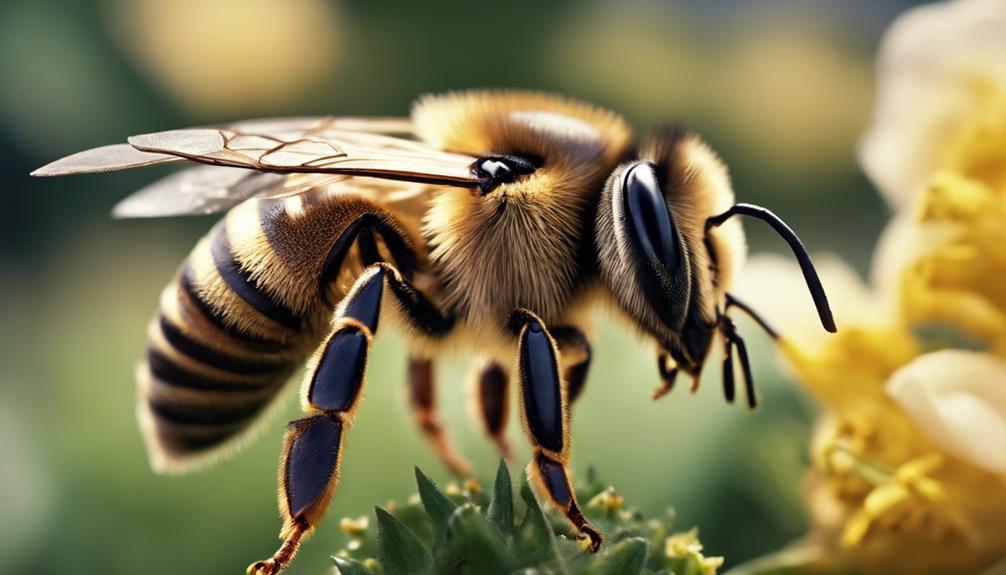
Understanding the genetic characteristics of worker bees sheds light on their crucial role within the hive and the fascinating mechanisms driving their behavior.
Worker bees, being genetically female with two sets of chromosomes, possess ovaries that are typically suppressed by pheromones released by the queen. This suppression prevents them from mating and laying fertilized eggs, leading to their role as sterile females in the colony.
The genetic makeup of worker bees also influences their altruistic behavior towards the survival of the hive, as explained by kin selection theory. These genetic traits not only define the biological functions of worker bees but also contribute to the intricate social structure and division of labor within the colony.

Roger Thomas is a seasoned beekeeper and hive architect with a deep-seated passion for sustainable living. His fascination with bees has shaped his professional career, giving him practical and theoretical expertise in bee behavior, colony health, and optimal hive conditions. Roger’s technical skills shine in his bespoke hive creations that cater to the specific needs of diverse bee species, while his sustainable practices promote environmental balance and the wellbeing of the bee population.
As he continues his journey in beekeeping, Roger has become a dedicated advocate for responsible practices and an insightful educator in his field. His posts aim to inspire new beekeepers, underline the importance of sustainability, and showcase the remarkable contribution bees make to our ecosystem. Roger invites you to join him as he delves into the world of bees and the rewarding, honey-sweet art of beekeeping.
